A Polarization-Insensitive, Vanadium Dioxide-Based Dynamically Tunable Multiband Terahertz Metamaterial Absorber
Abstract
:1. Introduction
2. Materials and Methods
3. Results and Discussion
4. Conclusions
Author Contributions
Funding
Institutional Review Board Statement
Informed Consent Statement
Data Availability Statement
Conflicts of Interest
References
- Song, H.J.; Nagatsuma, T. Present and future of terahertz communications. IEEE Trans. Terahertz Sci. Technol. 2011, 1, 256–263. [Google Scholar] [CrossRef]
- Aghaee, T.; Orouji, A.A. Reconfigurable multi-band, graphene-based THz absorber: Circuit model approach. Results Phys. 2020, 16, 102855. [Google Scholar] [CrossRef]
- Xu, K.D.; Li, J.; Zhang, A.; Chen, Q. Tunable multi-band terahertz absorber using a single-layer square graphene ring structure with T-shaped graphene strips. Opt. Express 2020, 28, 11482–11492. [Google Scholar] [CrossRef]
- Barzegar-Parizi, S.; Ebrahimi, A. Ultrathin, polarization-insensitive multi-band absorbers based on graphene metasurface with THz sensing application. JOSA B 2020, 37, 2372–2381. [Google Scholar] [CrossRef]
- Yao, H.; Mei, H.; Zhang, W.; Zhong, S.; Wang, X. Theoretical and experimental research on terahertz metamaterial sensor with flexible substrate. IEEE Photonics J. 2021, 14, 3700109. [Google Scholar] [CrossRef]
- Shigekawa, H.; Yoshida, S.; Takeuchi, O. Spectroscopy: Nanoscale terahertz spectroscopy. Nat. Photonics 2014, 8, 815. [Google Scholar] [CrossRef]
- Chen, H.T.; O’Hara, J.F.; Azad, A.K.; Taylor, A.J. Manipulation of terahertz radiation using metamaterials. Laser Photonics Rev. 2011, 5, 513–533. [Google Scholar] [CrossRef]
- Valentine, J.; Zhang, S.; Zentgraf, T.; Ulin-Avila, E.; Genov, D.A.; Bartal, G.; Zhang, X. Three-dimensional optical metamaterial with a negative refractive index. Nature 2008, 455, 376–379. [Google Scholar] [CrossRef]
- Sihvola, A. Metamaterials in electromagnetics. Metamaterials 2007, 1, 2–11. [Google Scholar] [CrossRef]
- Cao, T.; Wei, C.w.; Simpson, R.E.; Zhang, L.; Cryan, M.J. Broadband polarization-independent perfect absorber using a phase-change metamaterial at visible frequencies. Sci. Rep. 2014, 4, 3955. [Google Scholar] [CrossRef]
- Liang, Y.; Lin, H.; Koshelev, K.; Zhang, F.; Yang, Y.; Wu, J.; Kivshar, Y.; Jia, B. Full-stokes polarization perfect absorption with diatomic metasurfaces. Nano Lett. 2021, 21, 1090–1095. [Google Scholar] [CrossRef] [PubMed]
- Dregely, D.; Taubert, R.; Dorfmüller, J.; Vogelgesang, R.; Kern, K.; Giessen, H. 3D optical Yagi–Uda nanoantenna array. Nat. Commun. 2011, 2, 267. [Google Scholar] [CrossRef] [PubMed]
- Xu, C.; Ren, Z.; Wei, J.; Lee, C. Reconfigurable terahertz metamaterials: From fundamental principles to advanced 6G applications. Iscience 2022, 25, 103799. [Google Scholar] [CrossRef]
- Pan, J.; Hu, H.; Li, Z.; Mu, J.; Cai, Y.; Zhu, H. Recent progress in two-dimensional materials for terahertz protection. Nanoscale Adv. 2021, 3, 1515–1531. [Google Scholar] [CrossRef] [PubMed]
- Manikandan, E.; Karthigeyan, K.A.; Arivarasi, A.; Papanasam, E. High-Q and FOM Dual-Band Polarization Dependent Ultra-Narrowband Terahertz Metamaterial Sensor. IEEE Photonics J. 2023, 15, 0600206. [Google Scholar] [CrossRef]
- Landy, N.I.; Sajuyigbe, S.; Mock, J.J.; Smith, D.R.; Padilla, W.J. Perfect metamaterial absorber. Phys. Rev. Lett. 2008, 100, 207402. [Google Scholar] [CrossRef]
- Le, D.T.; Tong, B.T.; Nguyen, T.K.T.; Cao, T.N.; Nguyen, H.Q.; Tran, M.C.; Truong, C.L.; Bui, X.K.; Vu, D.L.; Nguyen, T.Q.H. Polarization-insensitive dual-band terahertz metamaterial absorber based on asymmetric arrangement of two rectangular-shaped resonators. Optik 2021, 245, 167669. [Google Scholar] [CrossRef]
- Shan, Y.; Chen, L.; Shi, C.; Cheng, Z.; Zang, X.; Xu, B.; Zhu, Y. Ultrathin flexible dual band terahertz absorber. Opt. Commun. 2015, 350, 63–70. [Google Scholar] [CrossRef]
- Wang, B.X.; Wang, G.Z. Novel quad-band terahertz metamaterial absorber based on single pattern U-shaped resonator. Appl. Phys. Express 2017, 10, 034301. [Google Scholar] [CrossRef]
- Wang, B.X.; Xu, C.; Duan, G.; Xu, W.; Pi, F. Review of broadband metamaterial absorbers: From principles, design strategies, and tunable properties to functional applications. Adv. Funct. Mater. 2023, 33, 2213818. [Google Scholar] [CrossRef]
- Wang, B.X.; Wang, G.Z.; Sang, T.; Wang, L.L. Six-band terahertz metamaterial absorber based on the combination of multiple-order responses of metallic patches in a dual-layer stacked resonance structure. Sci. Rep. 2017, 7, 41373. [Google Scholar] [CrossRef] [PubMed]
- Wang, D.; Zhang, L.; Gu, Y.; Mehmood, M.; Gong, Y.; Srivastava, A.; Jian, L.; Venkatesan, T.; Qiu, C.W.; Hong, M. Switchable ultrathin quarter-wave plate in terahertz using active phase-change metasurface. Sci. Rep. 2015, 5, 15020. [Google Scholar] [CrossRef] [PubMed]
- Barreda, A.; Zou, C.; Sinelnik, A.; Menshikov, E.; Sinev, I.; Pertsch, T.; Staude, I. Tuning and switching effects of quasi-BIC states combining phase change materials with all-dielectric metasurfaces. Opt. Mater. Express 2022, 12, 3132–3142. [Google Scholar] [CrossRef]
- Wang, R.; Li, L.; Liu, J.; Yan, F.; Tian, F.; Tian, H.; Zhang, J.; Sun, W. Triple-band tunable perfect terahertz metamaterial absorber with liquid crystal. Opt. Express 2017, 25, 32280–32289. [Google Scholar] [CrossRef]
- Savo, S.; Shrekenhamer, D.; Padilla, W.J. Liquid crystal metamaterial absorber spatial light modulator for THz applications. Adv. Opt. Mater. 2014, 2, 275–279. [Google Scholar] [CrossRef]
- Upender, P.; Kumar, A. Graphene-based ultra-wideband absorber for terahertz applications using hexagonal split ring resonators. Phys. Scr. 2022, 97, 065503. [Google Scholar] [CrossRef]
- Ye, L.; Zeng, F.; Zhang, Y.; Liu, Q.H. Composite graphene-metal microstructures for enhanced multiband absorption covering the entire terahertz range. Carbon 2019, 148, 317–325. [Google Scholar] [CrossRef]
- Zakir, S.; Bilal, R.M.H.; Naveed, M.A.; Baqir, M.A.; Khan, M.U.A.; Ali, M.M.; Saeed, M.A.; Mehmood, M.Q.; Massoud, Y. Polarization-insensitive, broadband, and tunable terahertz absorber using slotted-square graphene meta-rings. IEEE Photonics J. 2022, 15, 4600108. [Google Scholar] [CrossRef]
- Khodadadi, B.; Babaeinik, M.; Ghods, V.; Rezaei, P. Triple-band metamaterial perfect absorber for refractive index sensing in THz frequency. Opt. Quantum Electron. 2023, 55, 431. [Google Scholar] [CrossRef]
- Jeong, Y.G.; Bahk, Y.M.; Kim, D.S. Dynamic terahertz plasmonics enabled by phase-change materials. Adv. Opt. Mater. 2020, 8, 1900548. [Google Scholar] [CrossRef]
- Jeong, Y.G.; Han, S.; Rhie, J.; Kyoung, J.S.; Choi, J.W.; Park, N.; Hong, S.; Kim, B.J.; Kim, H.T.; Kim, D.S. A vanadium dioxide metamaterial disengaged from insulator-to-metal transition. Nano Lett. 2015, 15, 6318–6323. [Google Scholar] [CrossRef] [PubMed]
- Liu, M.; Hwang, H.Y.; Tao, H.; Strikwerda, A.C.; Fan, K.; Keiser, G.R.; Sternbach, A.J.; West, K.G.; Kittiwatanakul, S.; Lu, J.; et al. Terahertz-field-induced insulator-to-metal transition in vanadium dioxide metamaterial. Nature 2012, 487, 345–348. [Google Scholar] [CrossRef] [PubMed]
- Li, W.; Xu, M.; Xu, H.X.; Wang, X.; Huang, W. Metamaterial absorbers: From tunable surface to structural transformation. Adv. Mater. 2022, 34, 2202509. [Google Scholar] [CrossRef] [PubMed]
- Zhang, M.; Zhang, J.; Chen, A.; Song, Z. Vanadium dioxide-based bifunctional metamaterial for terahertz waves. IEEE Photonics J. 2019, 12, 4600109. [Google Scholar] [CrossRef]
- Driscoll, T.; Kim, H.T.; Chae, B.G.; Kim, B.J.; Lee, Y.W.; Jokerst, N.M.; Palit, S.; Smith, D.R.; Di Ventra, M.; Basov, D.N. Memory metamaterials. Science 2009, 325, 1518–1521. [Google Scholar] [CrossRef] [PubMed]
- Liu, L.; Kang, L.; Mayer, T.S.; Werner, D.H. Hybrid metamaterials for electrically triggered multifunctional control. Nat. Commun. 2016, 7, 13236. [Google Scholar] [CrossRef]
- Hu, B.; Huang, M.; Li, P.; Yang, J. Dynamically dual-tunable dual-band to four-band metamaterial absorbers based on bulk Dirac semimetal and vanadium dioxide. JOSA A 2022, 39, 383–391. [Google Scholar] [CrossRef]
- Ri, K.J.; Kim, J.S.; Kim, J.H.; Ri, C.H. Tunable triple-broadband terahertz metamaterial absorber using a single VO2 circular ring. Opt. Commun. 2023, 542, 129573. [Google Scholar] [CrossRef]
- Zheng, Z.; Zheng, Y.; Luo, Y.; Yi, Z.; Zhang, J.; Liu, Z.; Yang, W.; Yu, Y.; Wu, X.; Wu, P. A switchable terahertz device combining ultra-wideband absorption and ultra-wideband complete reflection. Phys. Chem. Chem. Phys. 2022, 24, 2527–2533. [Google Scholar] [CrossRef] [PubMed]
- Abdulkarim, Y.I.; Awl, H.N.; Muhammadsharif, F.F.; Bakır, M.; Alkurt, F.Ö.; Altıntaş, O.; Saeed, S.R.; Taouzari, M.; Karaaslan, M.; Appasani, B.; et al. A vanadium dioxide-based metamaterial with quatrefoil and circle loaded structure on flexible polyamide substrate for terahertz applications. Front. Phys. 2022, 10, 968310. [Google Scholar] [CrossRef]
- Ma, T.; Liu, G.; Su, L.; Sun, B.; Ma, L.; Liu, H. Thermo-optical and electro-optical tunable dual-band THz absorber based on multi-layer hybrid VO2 phase transition metamaterial. Opt. Commun. 2023, 549, 129906. [Google Scholar] [CrossRef]
- Watts, C.M.; Liu, X.; Padilla, W.J. Metamaterial electromagnetic wave absorbers. Adv. Mater. 2012, 24, OP98–OP120. [Google Scholar] [CrossRef]
- Niu, J.; Hui, Q.; Mo, W.; Yao, Q.; Gong, H.; Tian, R.; Zhu, A. A dual functional tunable terahertz metamaterial absorber based on vanadium dioxide. Phys. Chem. Chem. Phys. 2024, 26, 10633–10640. [Google Scholar] [CrossRef]
- Li, J.; Liu, Y.; Chen, Y.; Chen, W.; Guo, H.; Wu, Q.; Li, M. Tunable broadband-narrowband and dual-broadband terahertz absorber based on a hybrid metamaterial vanadium dioxide and graphene. Micromachines 2023, 14, 201. [Google Scholar] [CrossRef] [PubMed]
- Zhang, T.; Yang, S.; Yu, X. Tunable multiple broadband terahertz perfect absorber based on vanadium dioxide. Opt. Commun. 2021, 501, 127358. [Google Scholar] [CrossRef]
- Lin, H.; Zou, Y.; Wu, Y.; Xiahou, X.; Zhu, H.; Zhang, X.; Wang, B.X. Study on vanadium dioxide based terahertz metamaterials with switchable functions from five-band absorption to triple-band plasmon-induced transparency. Phys. Scr. 2023, 98, 035510. [Google Scholar] [CrossRef]
- Naftaly, M.; Miles, R. Terahertz time-domain spectroscopy of silicate glasses and the relationship to material properties. J. Appl. Phys. 2007, 102. [Google Scholar] [CrossRef]
- Liu, N.; Langguth, L.; Weiss, T.; Kästel, J.; Fleischhauer, M.; Pfau, T.; Giessen, H. Plasmonic analogue of electromagnetically induced transparency at the Drude damping limit. Nat. Mater. 2009, 8, 758–762. [Google Scholar] [CrossRef]
- Li, W.; Chang, S.j.; Wang, X.h.; Lin, L.; Bai, J.j. A thermally tunable terahertz bandpass filter with insulator-metal phase transition of VO2 thin film. Optoelectron. Lett. 2014, 10, 180–183. [Google Scholar] [CrossRef]
- Mandal, P.; Speck, A.; Ko, C.; Ramanathan, S. Terahertz spectroscopy studies on epitaxial vanadium dioxide thin films across the metal-insulator transition. Opt. Lett. 2011, 36, 1927–1929. [Google Scholar] [CrossRef]
- Zhang, Y.; Wu, P.; Zhou, Z.; Chen, X.; Yi, Z.; Zhu, J.; Zhang, T.; Jile, H. Study on temperature adjustable terahertz metamaterial absorber based on vanadium dioxide. IEEE Access 2020, 8, 85154–85161. [Google Scholar] [CrossRef]
- Dong, T.; Zhang, Y.; Li, Y.; Tang, Y.; He, X. Dual-function switchable terahertz metamaterial device with dynamic tuning characteristics. Results Phys. 2023, 45, 106246. [Google Scholar] [CrossRef]
- Wong, H.; Wang, K.X.; Huitema, L.; Crunteanu, A. Active meta polarizer for terahertz frequencies. Sci. Rep. 2020, 10, 15382. [Google Scholar] [CrossRef]
- Smith, D.R.; Schultz, S.; Markoš, P.; Soukoulis, C. Determination of effective permittivity and permeability of metamaterials from reflection and transmission coefficients. Phys. Rev. B 2002, 65, 195104. [Google Scholar] [CrossRef]
- Song, Z.; Jiang, M.; Deng, Y.; Chen, A. Wide-angle absorber with tunable intensity and bandwidth realized by a terahertz phase change material. Opt. Commun. 2020, 464, 125494. [Google Scholar] [CrossRef]
- Liu, N.; Fu, L.; Kaiser, S.; Schweizer, H.; Giessen, H. Plasmonic building blocks for magnetic molecules in three-dimensional optical metamaterials. Adv. Mater. 2008, 20, 3859–3865. [Google Scholar] [CrossRef]
- Zhao, L.; Liu, H.; He, Z.; Dong, S. Theoretical design of twelve-band infrared metamaterial perfect absorber by combining the dipole, quadrupole, and octopole plasmon resonance modes of four different ring-strip resonators. Opt. Express 2018, 26, 12838–12851. [Google Scholar] [CrossRef] [PubMed]
- Chen, H.T. Interference theory of metamaterial perfect absorbers. Opt. Express 2012, 20, 7165–7172. [Google Scholar] [CrossRef]


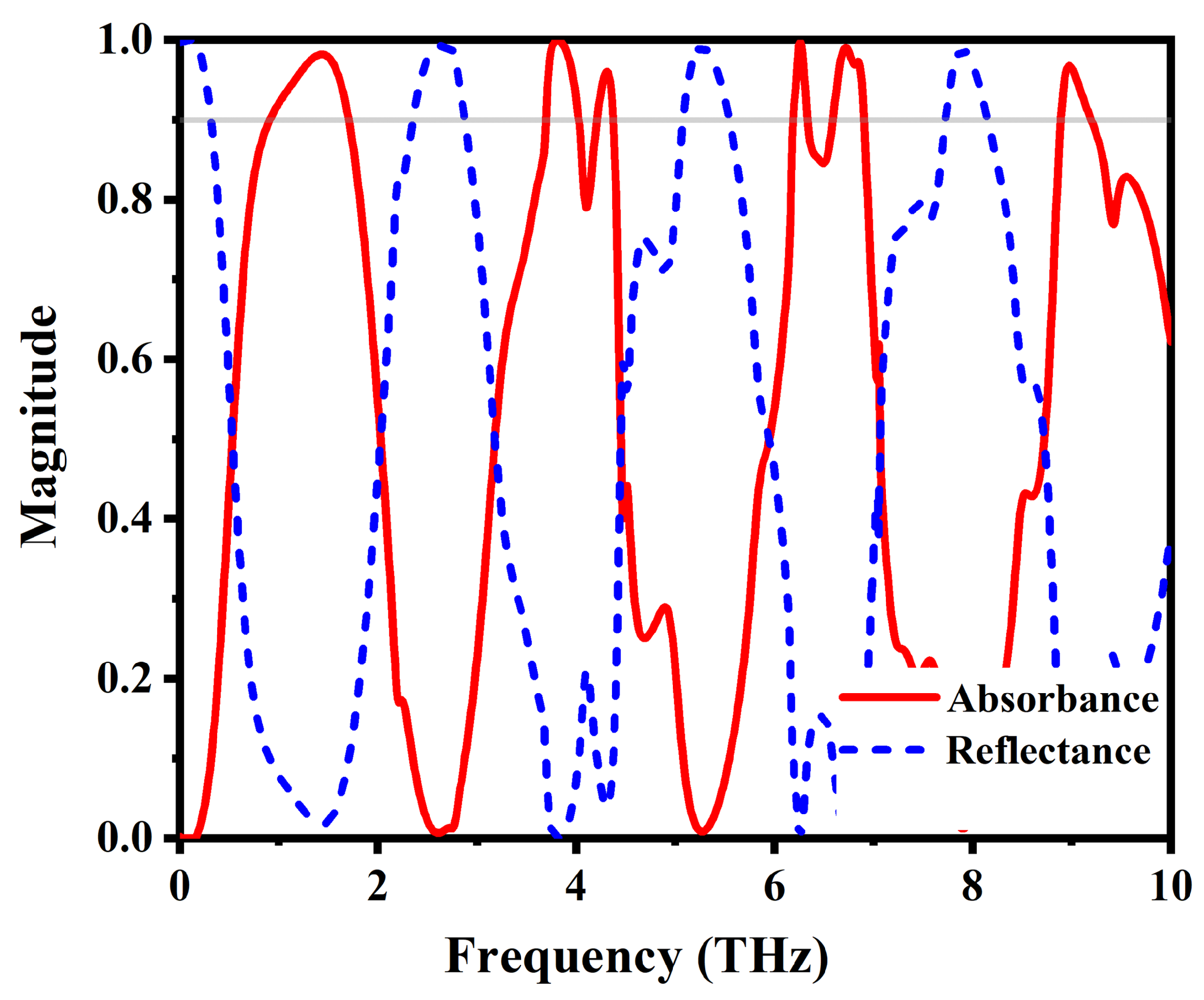

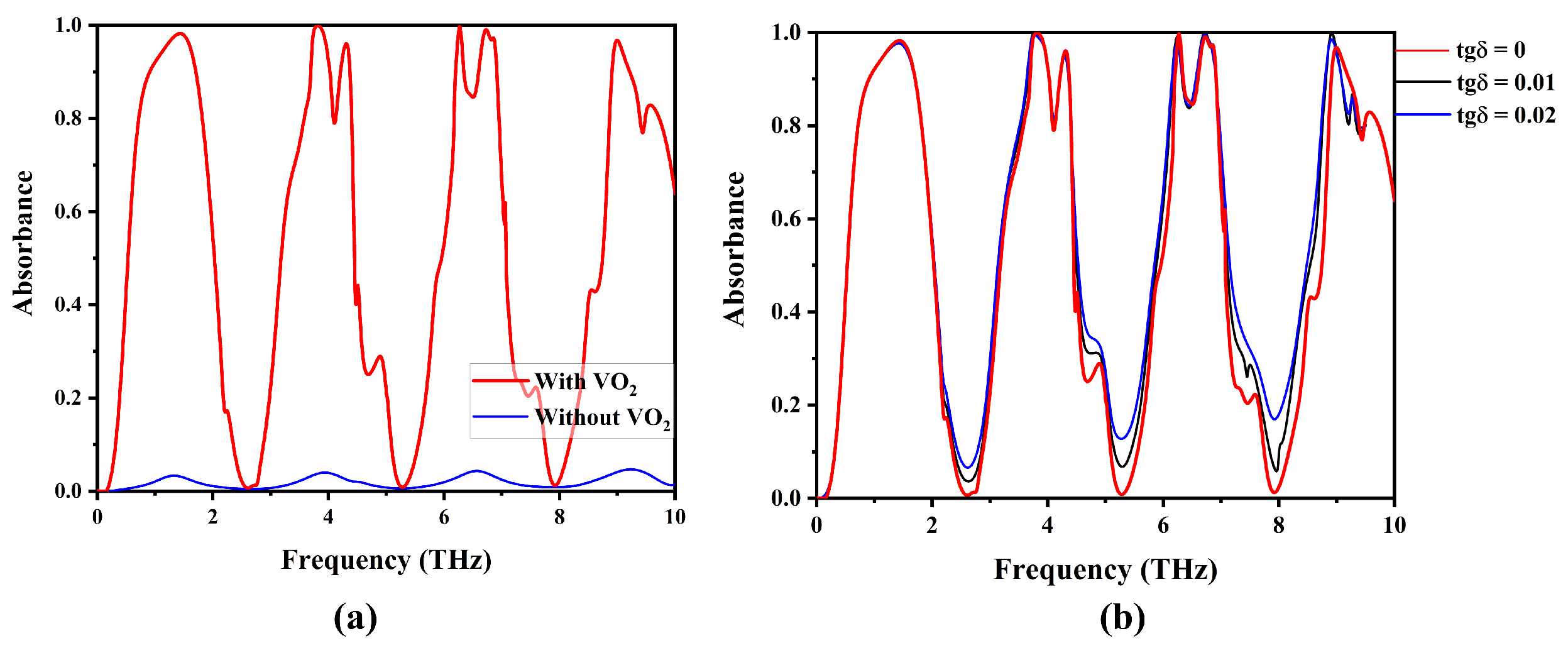


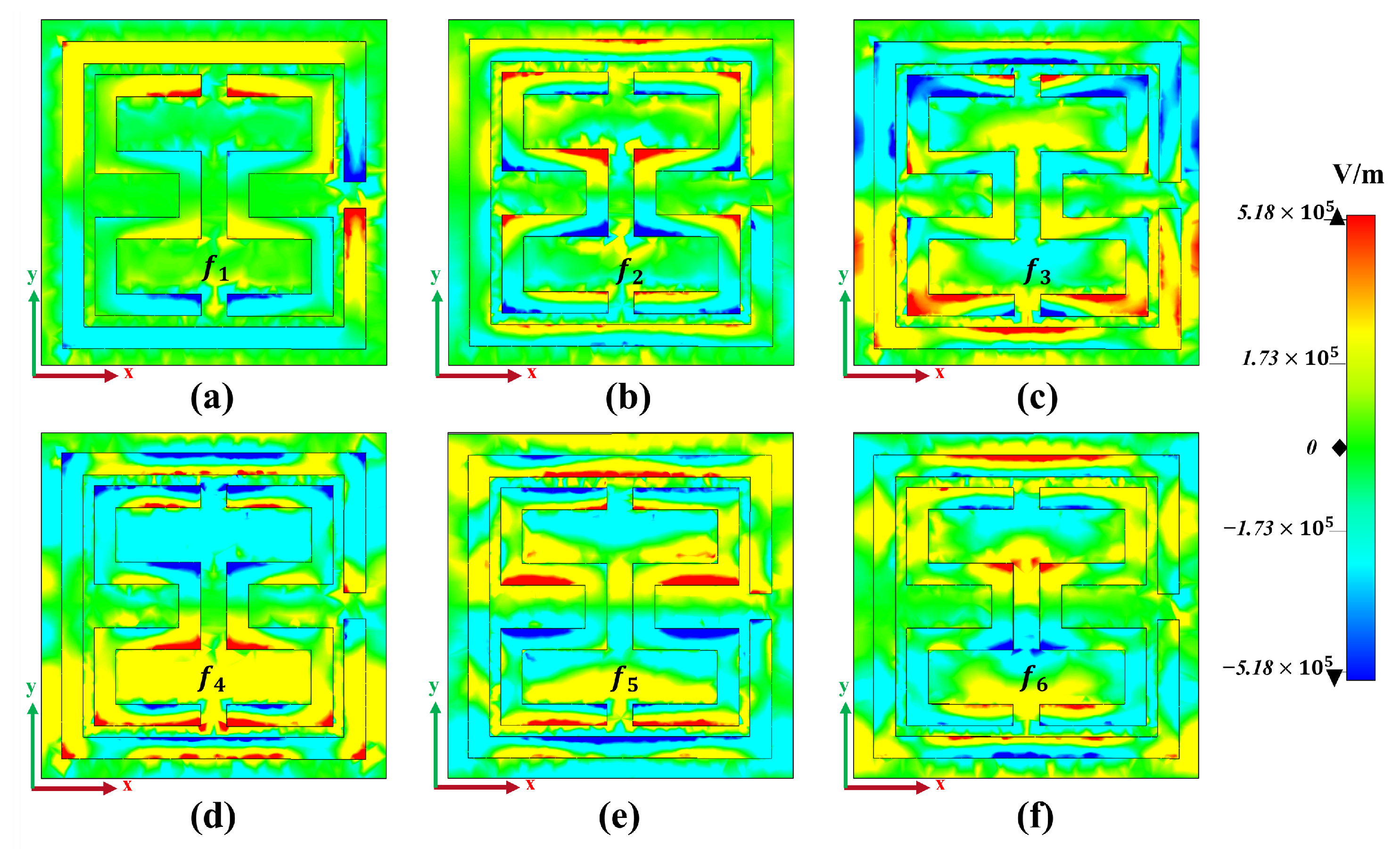
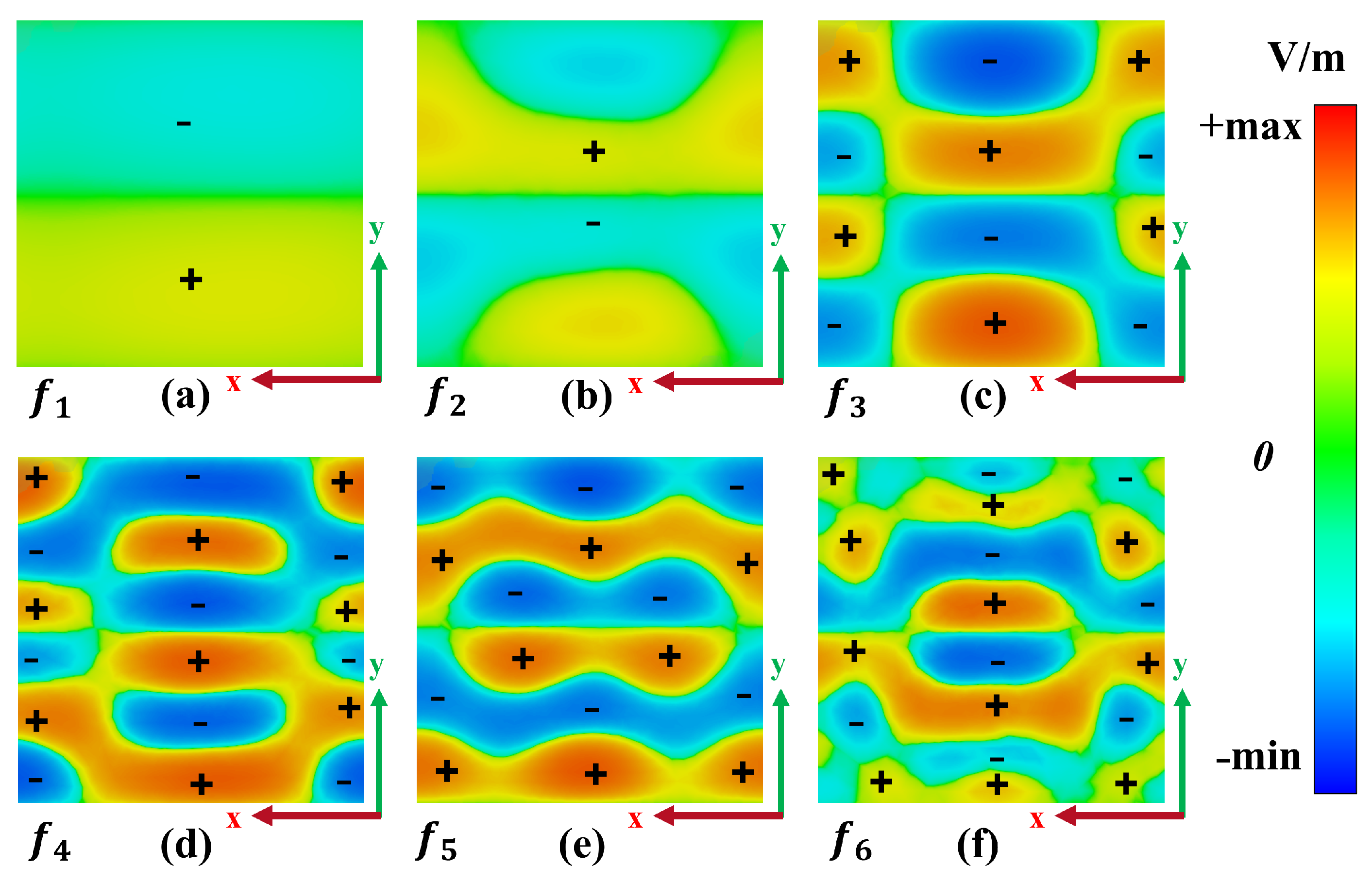
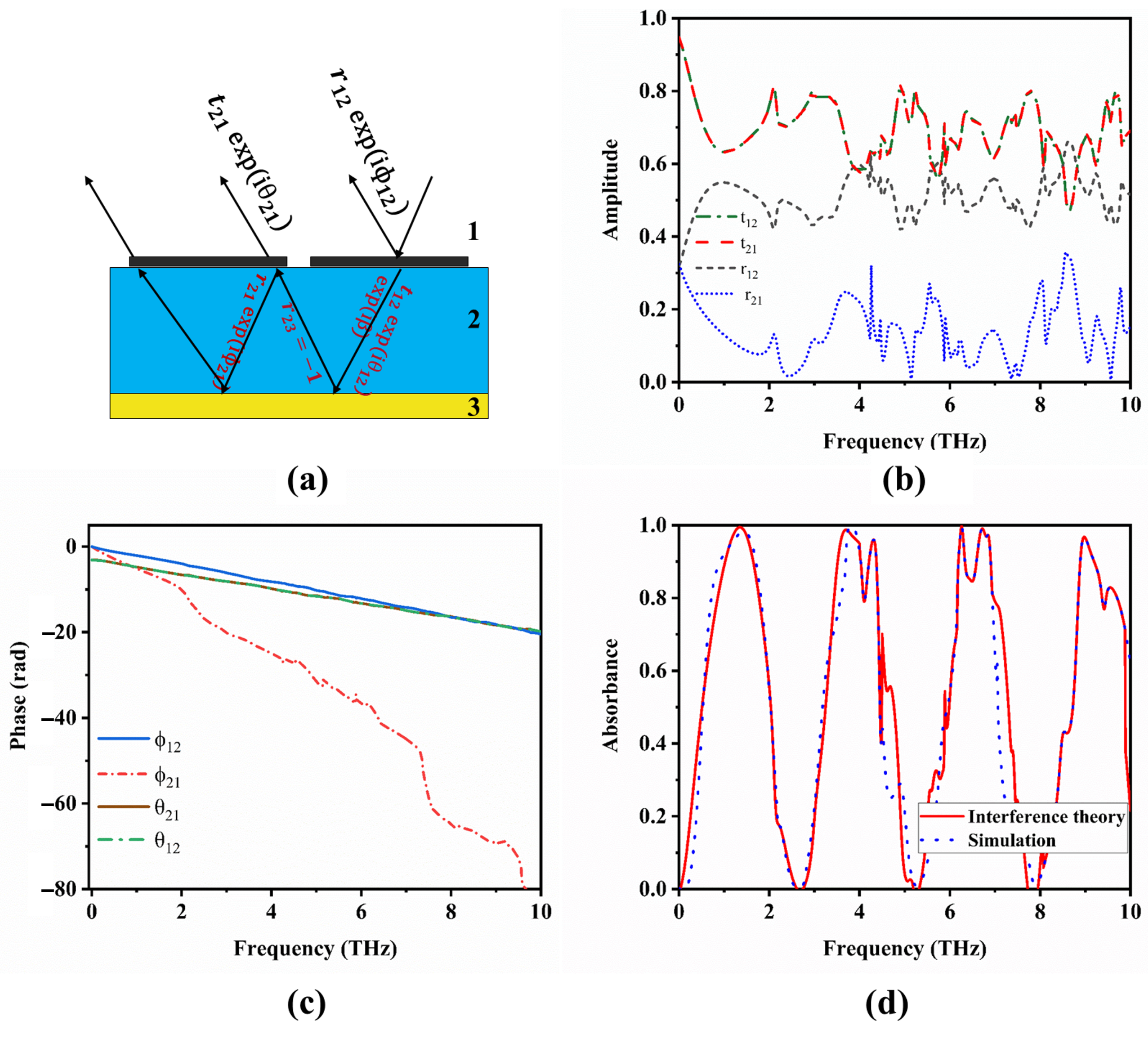
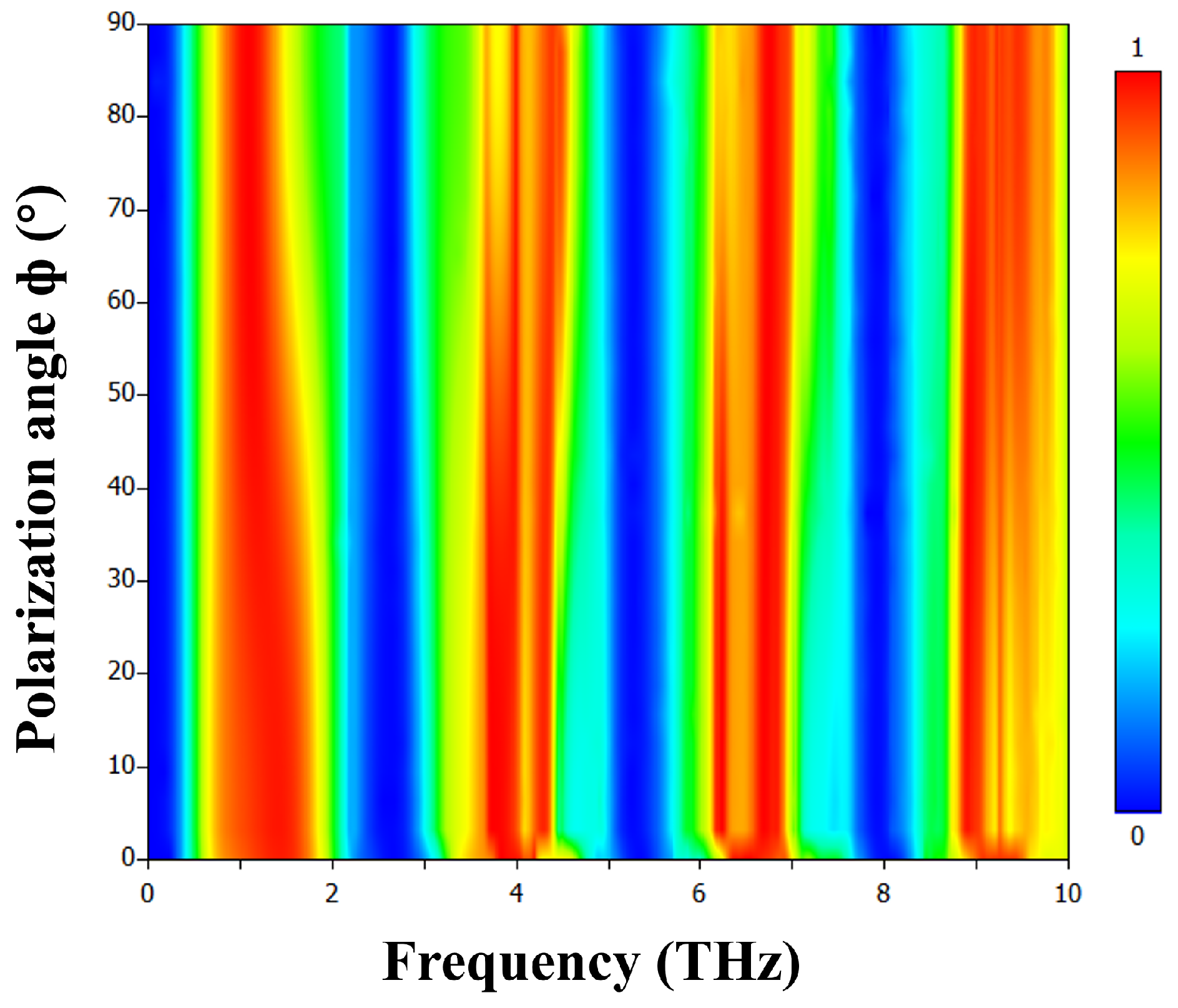
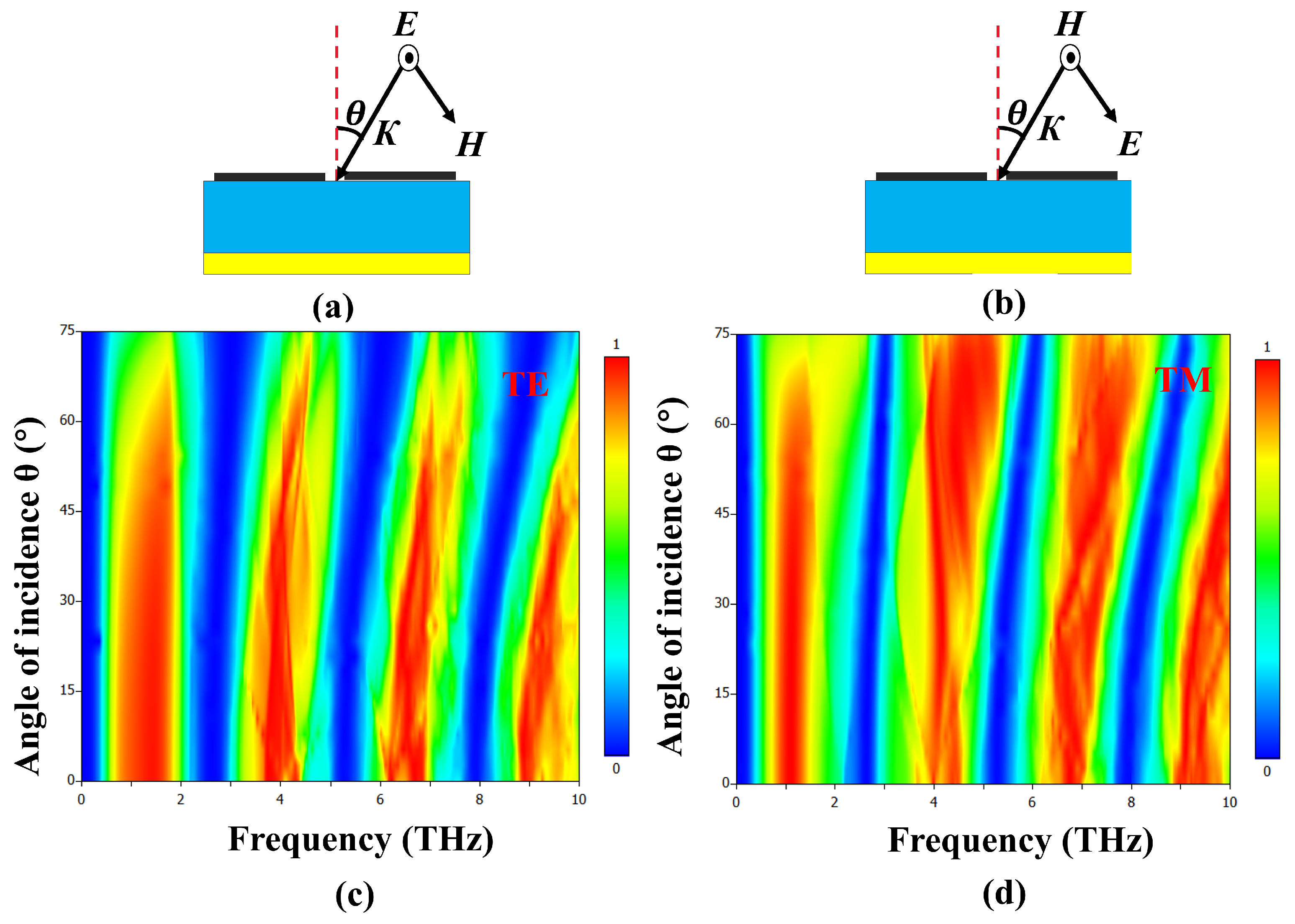

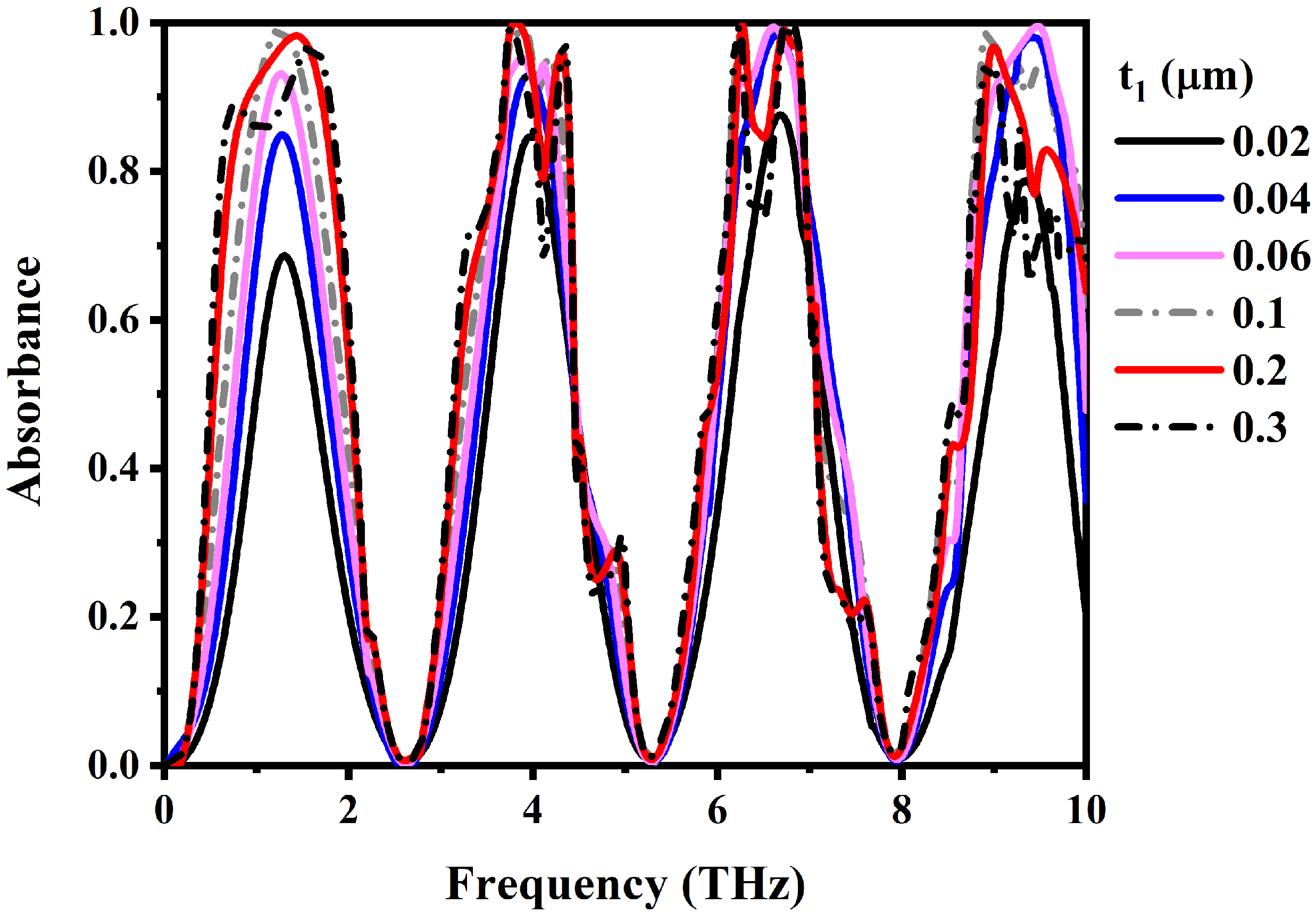
| Frequency (THz) | Number of Peaks | Average Absorption Rate (%) | Tunable Range (%) | Ref. |
|---|---|---|---|---|
| 0.1–2 | 1 | >90 | 20–99 | [40] |
| 5–8 | 2 | 99 | 36.2–99 | [41] |
| 1–9 | 3 | 99 | 30.4–99 | [42] |
| 0.1–12 | 3 | >90 | 20–90 | [38] |
| 2–5 | 4 | >97 | – | [43] |
| 6–10 | 4 | >88 | – | [44] |
| 2.5–5.5 | 4 | >96 | – | [37] |
| 0.1–9.5 | 5 | >98 | 7–99 | [45] |
| 0.1–3 | 5 | >98 | – | [46] |
| 0.1–10 | 6 | >98 | 4–99.9 | This work |
Disclaimer/Publisher’s Note: The statements, opinions and data contained in all publications are solely those of the individual author(s) and contributor(s) and not of MDPI and/or the editor(s). MDPI and/or the editor(s) disclaim responsibility for any injury to people or property resulting from any ideas, methods, instructions or products referred to in the content. |
© 2024 by the authors. Licensee MDPI, Basel, Switzerland. This article is an open access article distributed under the terms and conditions of the Creative Commons Attribution (CC BY) license (https://creativecommons.org/licenses/by/4.0/).
Share and Cite
Raza, M.; Li, X.; Mao, C.; Liu, F.; He, H.; Wu, W. A Polarization-Insensitive, Vanadium Dioxide-Based Dynamically Tunable Multiband Terahertz Metamaterial Absorber. Materials 2024, 17, 1757. https://doi.org/10.3390/ma17081757
Raza M, Li X, Mao C, Liu F, He H, Wu W. A Polarization-Insensitive, Vanadium Dioxide-Based Dynamically Tunable Multiband Terahertz Metamaterial Absorber. Materials. 2024; 17(8):1757. https://doi.org/10.3390/ma17081757
Chicago/Turabian StyleRaza, Mohsin, Xiaoman Li, Chenlu Mao, Fenghua Liu, Hongbo He, and Weiping Wu. 2024. "A Polarization-Insensitive, Vanadium Dioxide-Based Dynamically Tunable Multiband Terahertz Metamaterial Absorber" Materials 17, no. 8: 1757. https://doi.org/10.3390/ma17081757





